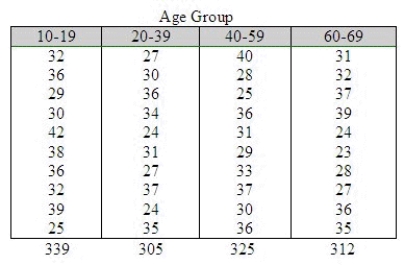Asked by Alexis Quackenbush on May 31, 2024

Verified
An experiment was conducted to examine the effect of age on heart rate when a person is subjected to a specific amount of exercise. Ten men randomly selected from each of four age groups: 10-19, 20-39, 40-59, and 60-69. Each man walked a treadmill at a fixed grade for a period of 12 minutes, and the increase in heart rate (the difference before and after exercise) was recorded (in beats per minute). The data are shown in the table.  Do the data present sufficient evidence to indicate differences in location for at least two of the four age groups? Test using the Kruskal-Wallis H test with
Do the data present sufficient evidence to indicate differences in location for at least two of the four age groups? Test using the Kruskal-Wallis H test with  = 0.01.
= 0.01.
What is H?
______________
What is the critical value for the test statistic?
Reject  if H > ______________
if H > ______________
Conclude: ______________
There is ______________ of a difference in location.
Find the approximate p-value for the test above.
______________
Kruskal-Wallis H Test
A nonparametric statistical test designed to assess whether there's a significant difference between two or more groups related to an independent variable, with respect to a continuous or ordinal dependent variable.
Heart Rate
The number of times the heart beats per minute, a vital sign used to assess the general physical health of an individual.
Age Groups
Categories of individuals segmented according to their ages, often used in research and demographic studies.
- Initiate the Kruskal-Wallis test to identify differences between more than two entities.
- Analyze the evidence and decisive factors of nonparametric tests.

Verified Answer

Learning Objectives
- Initiate the Kruskal-Wallis test to identify differences between more than two entities.
- Analyze the evidence and decisive factors of nonparametric tests.
Related questions
In a Kruskal-Wallis Test to Determine Whether Differences Exist Among ...
The Kruskal-Wallis Test Statistic Can Be Approximated by a Chi-Squared ...
A Researcher Was Interested in Comparing the GPAs of Students ...
Nonparametric Methods Are Designed to Test ____________________ Data
A Parametric Test Is a Hypothesis Test That Depends on ...